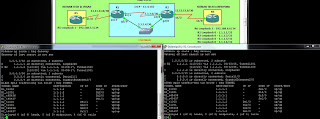In this topology we will be configuring both explicit/static tunnels/paths and also dynamic auto-tunnels.
Consider the simple topology below and let's get started.
Relevant configurations are posted below.
First what we need to do is get all the interfaces configured with IP and description.
 |
| R1 and R2 |
 |
| R5 and R6 |
 |
| R1 and R2 OSPF |
 |
| R1 and R2 enabling MPLS |
 |
| Get OSPF ready for MPLS. Get interfaces configured with MPLS / RSVP. |
 |
| Configure the 2 primary tunnels between R1 and R2. |
 |
| Configure 2 backup tunnels between R1 and R2. |
Now let's do a few show commands to verify everything.
 |
| Corner stone for MPLS -- LDP neighbors has to be formed!! |
 |
| Notice that all the tunnels are up and running. |
Notice how tunnel3 and tunnel4 both listed in the routing table meaning the traffic will be load balanced. Load balancing is unidirectional which is why I created 2 primary tunnels on R1 and R2. If I created 2 primary tunnel only on R1 then R1 will load balance but the return traffic from R2 will not be load balanced and would use GIG 2/0 since OSPF cost of GIG 2/0 is less and in case of a failure to GIG2/0 OSPF would have to install the backup Ser1/0 into R2 routing table and failover is not instantaneous.
The dot (.) inside the red box is when I shut the ser1/0 interface on R2. Notice how fast the failover happens. And notice when I do no shut the ser1/0 on R2 traffic load balances again between tunnel3 and tunnel4 without even dropping a packet. The dot (.) inside the green box is when I did a shut on gig2/0 on R2 and once again notice that the failover is almost instantaneous and when I do a no shut on the gig2/0 on R2 traffic load balances again between tunnel3 and tunnel4 without even dropping a packet. Thanks to fast re-reroute we can achieve failover times comparable to SONET.
Now let's imagine that HITMAN Tech has an office in VEGAS and an office in New York and HITMAN Tech want MPLS between them. Here is how to configure that. Configure a new vrf, get the serial interface in the vrf, and get BGP configured between R1 and R2 and the customer routers (R5 and R6).
 |
| R1 and R2 |
 |
| R5 and R6 |
 |
| R1 and R2 |
 |
| R5 and R6 |
R1
R2
R5
R6
If you wanted to save the hassle of creating static tunnels then follow the steps below to auto-tunnel. Make sure you first delete the static primary tunnels (3 & 4) and static backup tunnels (1000 and 2000) from R1 and R2 which we created above. Then on R1 and R2 type the following.
 |
| R1 and R2 |
 |
| Notice tunnels 1000 and 1001 are automatically created and so are the backup tunnels. |



That's a good tutorial.
ReplyDeleteYou should add something complex as interarea tunneling with OSPF/ISIS.
You didn't enabled LDP on TE tunnels. When implemented PE PE is not necessary but when its tails terminates on a P router, you must enable it.
ops... forgive me.... you didn't use MPLS VPNs....so LDP on tunnel can be avoided.
ReplyDelete